Themed Travel and Upcoming Trends: A Business Report
VerifiedAdded on 2021/04/21
|17
|5821
|66
Report
AI Summary
This report provides a comprehensive analysis of the themed travel industry, exploring its growth, macroeconomic factors, and future trends. It examines the industry's marketing mix, including product, pricing, promotion, and place strategies. The report delves into the segmentation, targeting, and positioning (STP) of the thematic tourism industry. It also analyzes risks, challenges, and the impact of factors like political instability, environmental changes, and data security. Furthermore, the report offers recommendations for tourism companies, such as diversifying thematic packages and establishing robust alert systems. The study highlights the industry's dependence on technology, globalization, and governmental support, while also acknowledging the importance of authentic tourist experiences and offbeat locations. The report concludes by emphasizing the need for proactive risk management and adaptability to ensure the continued success of thematic tourism.
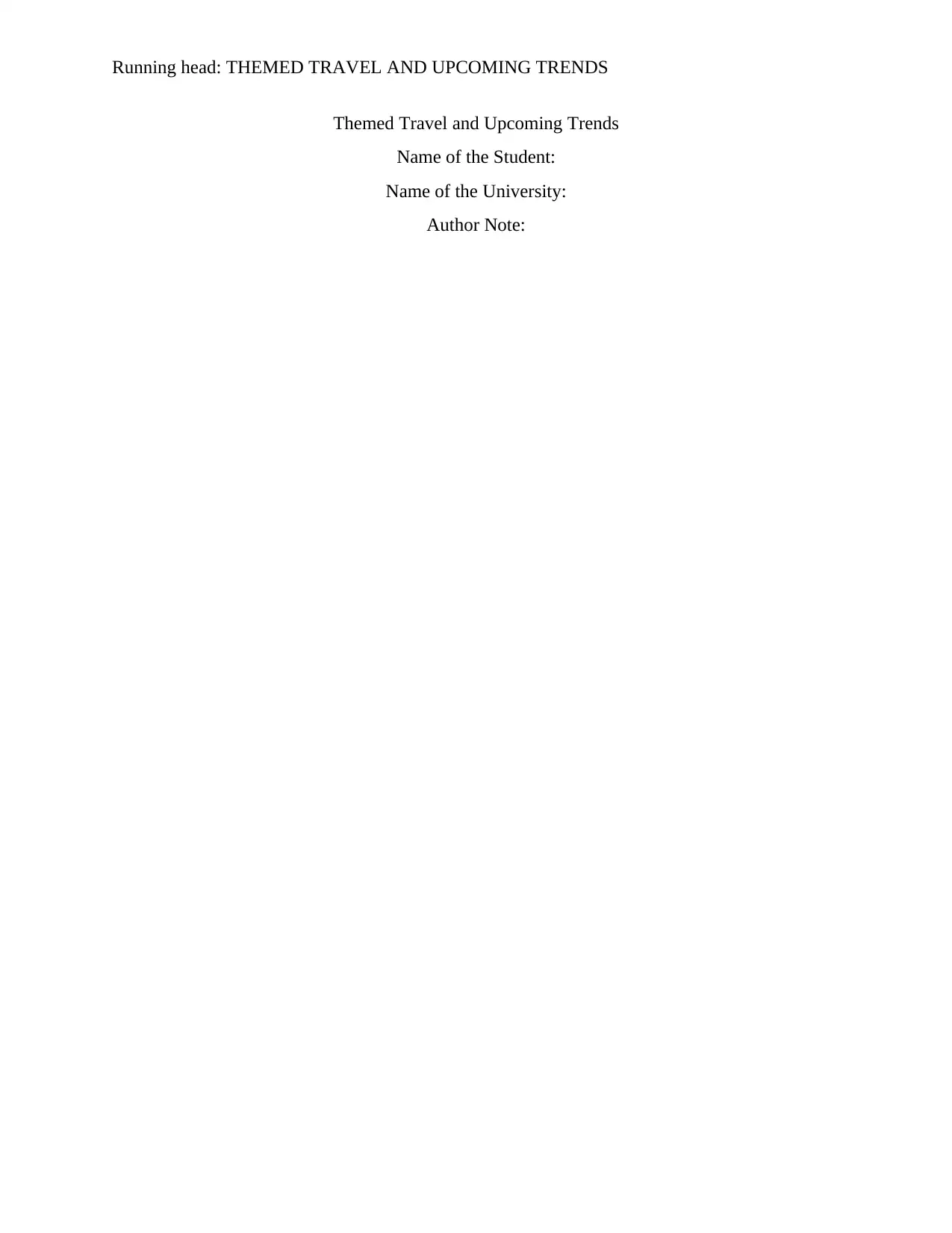
Running head: THEMED TRAVEL AND UPCOMING TRENDS
Themed Travel and Upcoming Trends
Name of the Student:
Name of the University:
Author Note:
Themed Travel and Upcoming Trends
Name of the Student:
Name of the University:
Author Note:
Paraphrase This Document
Need a fresh take? Get an instant paraphrase of this document with our AI Paraphraser
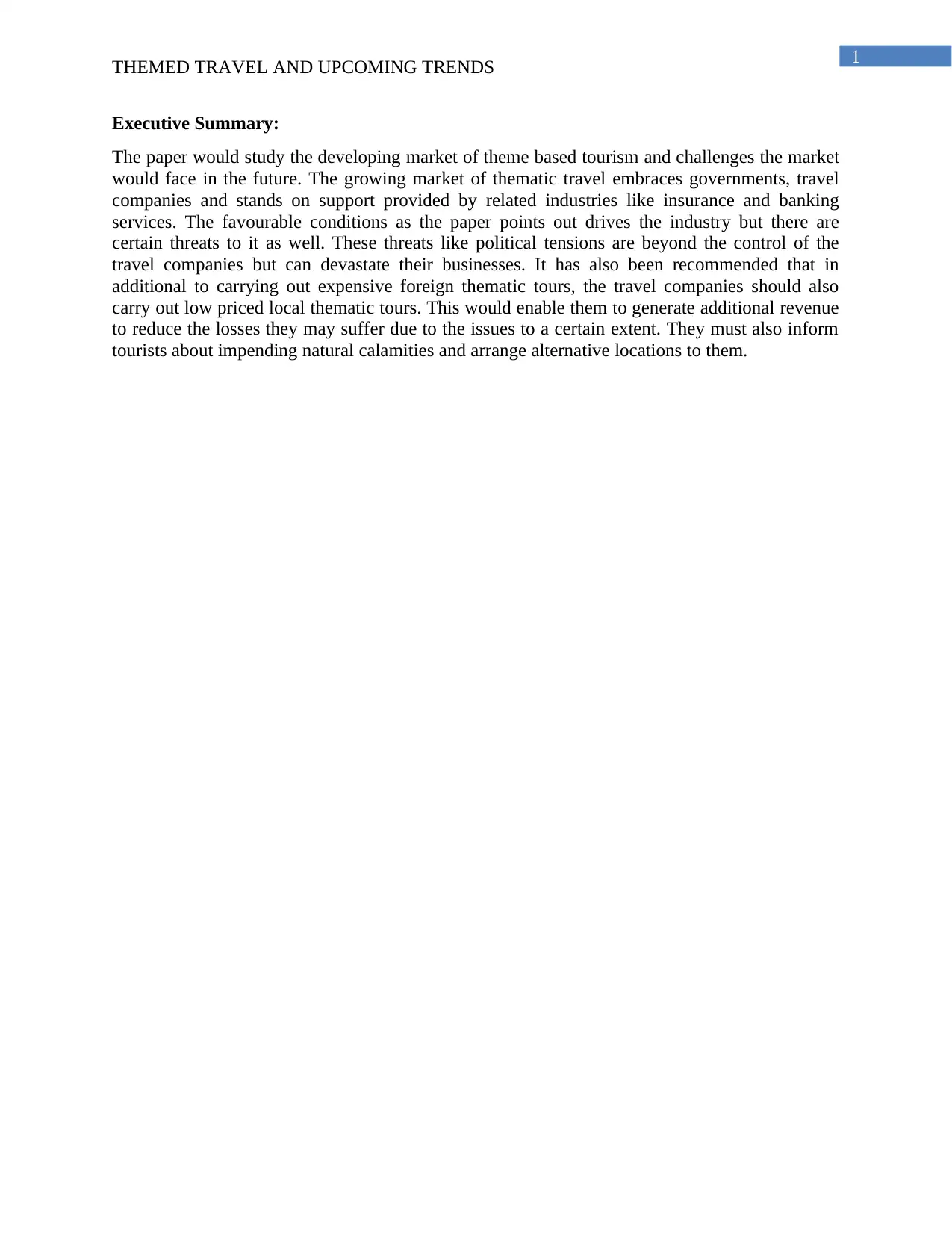
1
THEMED TRAVEL AND UPCOMING TRENDS
Executive Summary:
The paper would study the developing market of theme based tourism and challenges the market
would face in the future. The growing market of thematic travel embraces governments, travel
companies and stands on support provided by related industries like insurance and banking
services. The favourable conditions as the paper points out drives the industry but there are
certain threats to it as well. These threats like political tensions are beyond the control of the
travel companies but can devastate their businesses. It has also been recommended that in
additional to carrying out expensive foreign thematic tours, the travel companies should also
carry out low priced local thematic tours. This would enable them to generate additional revenue
to reduce the losses they may suffer due to the issues to a certain extent. They must also inform
tourists about impending natural calamities and arrange alternative locations to them.
THEMED TRAVEL AND UPCOMING TRENDS
Executive Summary:
The paper would study the developing market of theme based tourism and challenges the market
would face in the future. The growing market of thematic travel embraces governments, travel
companies and stands on support provided by related industries like insurance and banking
services. The favourable conditions as the paper points out drives the industry but there are
certain threats to it as well. These threats like political tensions are beyond the control of the
travel companies but can devastate their businesses. It has also been recommended that in
additional to carrying out expensive foreign thematic tours, the travel companies should also
carry out low priced local thematic tours. This would enable them to generate additional revenue
to reduce the losses they may suffer due to the issues to a certain extent. They must also inform
tourists about impending natural calamities and arrange alternative locations to them.
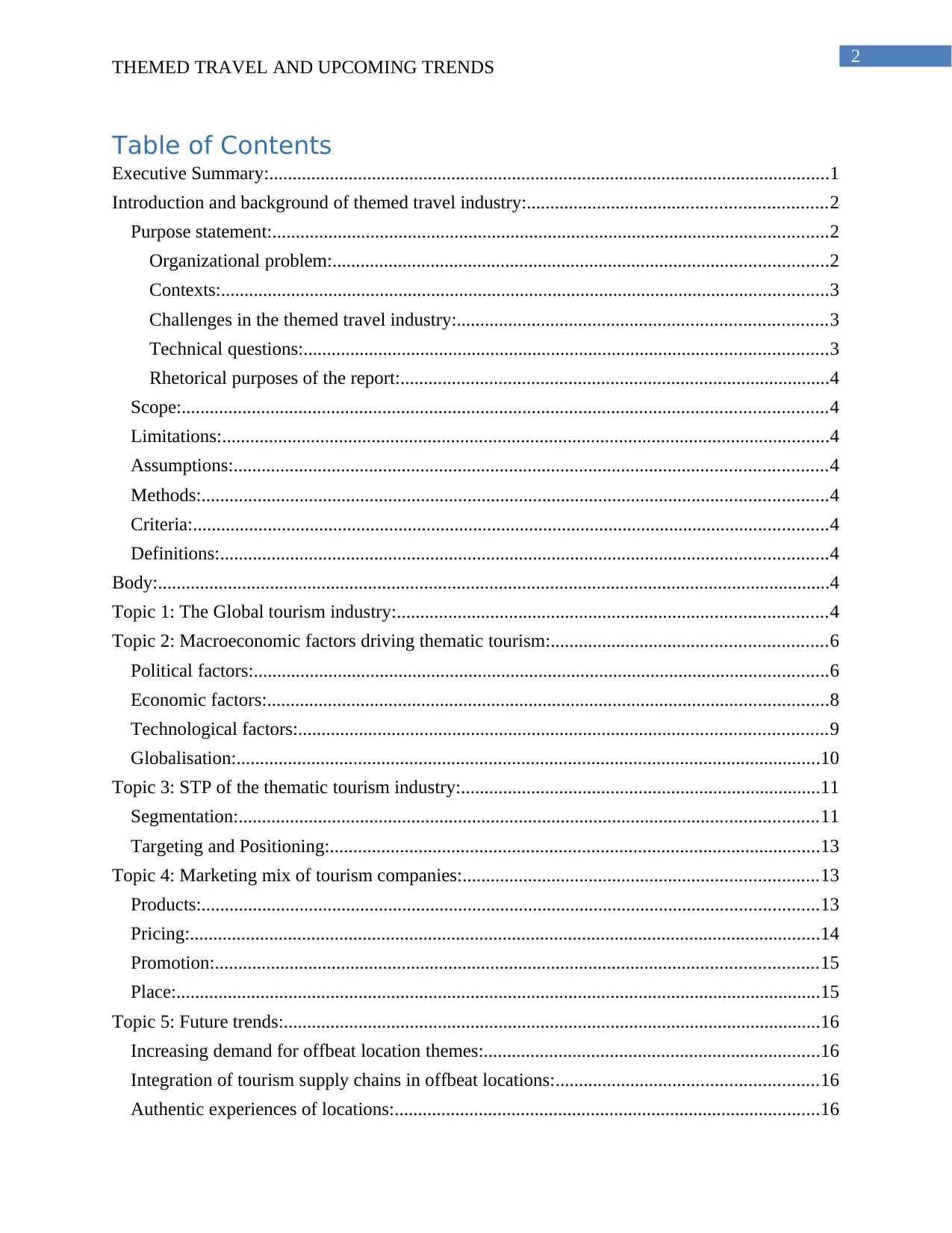
2
THEMED TRAVEL AND UPCOMING TRENDS
Table of Contents
Executive Summary:........................................................................................................................1
Introduction and background of themed travel industry:................................................................2
Purpose statement:.......................................................................................................................2
Organizational problem:..........................................................................................................2
Contexts:..................................................................................................................................3
Challenges in the themed travel industry:...............................................................................3
Technical questions:................................................................................................................3
Rhetorical purposes of the report:............................................................................................4
Scope:..........................................................................................................................................4
Limitations:..................................................................................................................................4
Assumptions:...............................................................................................................................4
Methods:......................................................................................................................................4
Criteria:........................................................................................................................................4
Definitions:..................................................................................................................................4
Body:................................................................................................................................................4
Topic 1: The Global tourism industry:............................................................................................4
Topic 2: Macroeconomic factors driving thematic tourism:...........................................................6
Political factors:...........................................................................................................................6
Economic factors:........................................................................................................................8
Technological factors:.................................................................................................................9
Globalisation:.............................................................................................................................10
Topic 3: STP of the thematic tourism industry:.............................................................................11
Segmentation:............................................................................................................................11
Targeting and Positioning:.........................................................................................................13
Topic 4: Marketing mix of tourism companies:............................................................................13
Products:....................................................................................................................................13
Pricing:.......................................................................................................................................14
Promotion:.................................................................................................................................15
Place:..........................................................................................................................................15
Topic 5: Future trends:...................................................................................................................16
Increasing demand for offbeat location themes:........................................................................16
Integration of tourism supply chains in offbeat locations:........................................................16
Authentic experiences of locations:...........................................................................................16
THEMED TRAVEL AND UPCOMING TRENDS
Table of Contents
Executive Summary:........................................................................................................................1
Introduction and background of themed travel industry:................................................................2
Purpose statement:.......................................................................................................................2
Organizational problem:..........................................................................................................2
Contexts:..................................................................................................................................3
Challenges in the themed travel industry:...............................................................................3
Technical questions:................................................................................................................3
Rhetorical purposes of the report:............................................................................................4
Scope:..........................................................................................................................................4
Limitations:..................................................................................................................................4
Assumptions:...............................................................................................................................4
Methods:......................................................................................................................................4
Criteria:........................................................................................................................................4
Definitions:..................................................................................................................................4
Body:................................................................................................................................................4
Topic 1: The Global tourism industry:............................................................................................4
Topic 2: Macroeconomic factors driving thematic tourism:...........................................................6
Political factors:...........................................................................................................................6
Economic factors:........................................................................................................................8
Technological factors:.................................................................................................................9
Globalisation:.............................................................................................................................10
Topic 3: STP of the thematic tourism industry:.............................................................................11
Segmentation:............................................................................................................................11
Targeting and Positioning:.........................................................................................................13
Topic 4: Marketing mix of tourism companies:............................................................................13
Products:....................................................................................................................................13
Pricing:.......................................................................................................................................14
Promotion:.................................................................................................................................15
Place:..........................................................................................................................................15
Topic 5: Future trends:...................................................................................................................16
Increasing demand for offbeat location themes:........................................................................16
Integration of tourism supply chains in offbeat locations:........................................................16
Authentic experiences of locations:...........................................................................................16
⊘ This is a preview!⊘
Do you want full access?
Subscribe today to unlock all pages.

Trusted by 1+ million students worldwide
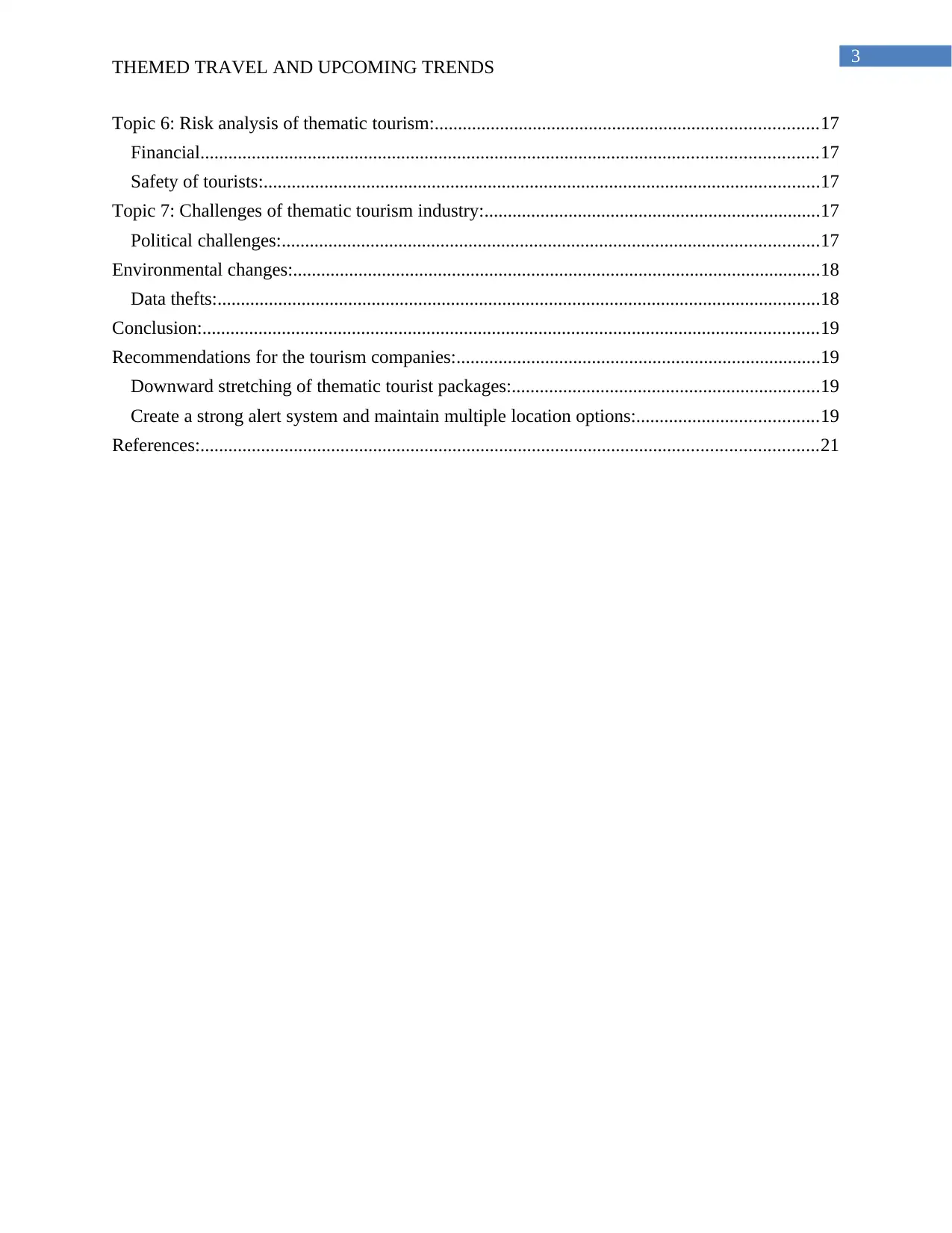
3
THEMED TRAVEL AND UPCOMING TRENDS
Topic 6: Risk analysis of thematic tourism:..................................................................................17
Financial....................................................................................................................................17
Safety of tourists:.......................................................................................................................17
Topic 7: Challenges of thematic tourism industry:........................................................................17
Political challenges:...................................................................................................................17
Environmental changes:.................................................................................................................18
Data thefts:.................................................................................................................................18
Conclusion:....................................................................................................................................19
Recommendations for the tourism companies:..............................................................................19
Downward stretching of thematic tourist packages:..................................................................19
Create a strong alert system and maintain multiple location options:.......................................19
References:....................................................................................................................................21
THEMED TRAVEL AND UPCOMING TRENDS
Topic 6: Risk analysis of thematic tourism:..................................................................................17
Financial....................................................................................................................................17
Safety of tourists:.......................................................................................................................17
Topic 7: Challenges of thematic tourism industry:........................................................................17
Political challenges:...................................................................................................................17
Environmental changes:.................................................................................................................18
Data thefts:.................................................................................................................................18
Conclusion:....................................................................................................................................19
Recommendations for the tourism companies:..............................................................................19
Downward stretching of thematic tourist packages:..................................................................19
Create a strong alert system and maintain multiple location options:.......................................19
References:....................................................................................................................................21
Paraphrase This Document
Need a fresh take? Get an instant paraphrase of this document with our AI Paraphraser
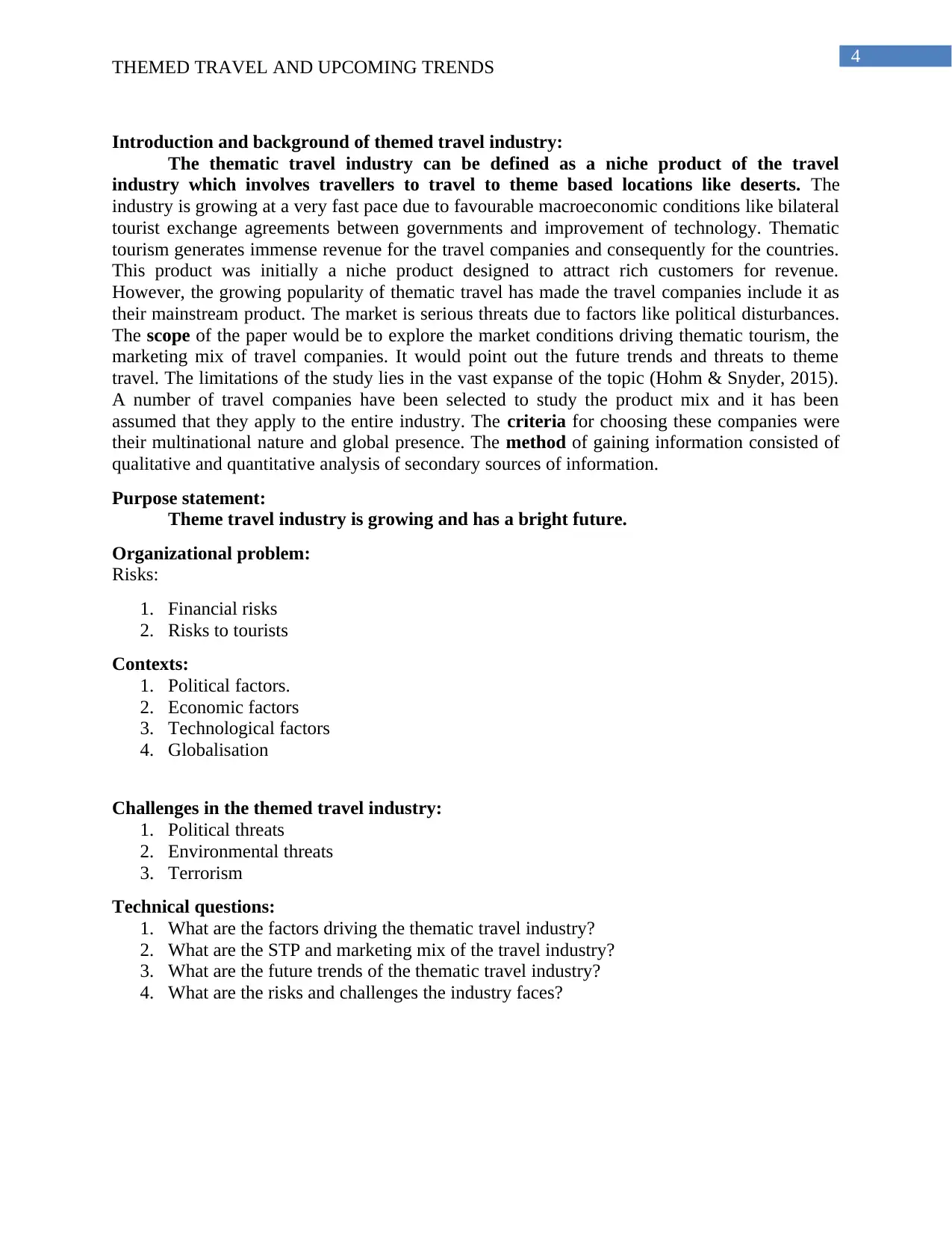
4
THEMED TRAVEL AND UPCOMING TRENDS
Introduction and background of themed travel industry:
The thematic travel industry can be defined as a niche product of the travel
industry which involves travellers to travel to theme based locations like deserts. The
industry is growing at a very fast pace due to favourable macroeconomic conditions like bilateral
tourist exchange agreements between governments and improvement of technology. Thematic
tourism generates immense revenue for the travel companies and consequently for the countries.
This product was initially a niche product designed to attract rich customers for revenue.
However, the growing popularity of thematic travel has made the travel companies include it as
their mainstream product. The market is serious threats due to factors like political disturbances.
The scope of the paper would be to explore the market conditions driving thematic tourism, the
marketing mix of travel companies. It would point out the future trends and threats to theme
travel. The limitations of the study lies in the vast expanse of the topic (Hohm & Snyder, 2015).
A number of travel companies have been selected to study the product mix and it has been
assumed that they apply to the entire industry. The criteria for choosing these companies were
their multinational nature and global presence. The method of gaining information consisted of
qualitative and quantitative analysis of secondary sources of information.
Purpose statement:
Theme travel industry is growing and has a bright future.
Organizational problem:
Risks:
1. Financial risks
2. Risks to tourists
Contexts:
1. Political factors.
2. Economic factors
3. Technological factors
4. Globalisation
Challenges in the themed travel industry:
1. Political threats
2. Environmental threats
3. Terrorism
Technical questions:
1. What are the factors driving the thematic travel industry?
2. What are the STP and marketing mix of the travel industry?
3. What are the future trends of the thematic travel industry?
4. What are the risks and challenges the industry faces?
THEMED TRAVEL AND UPCOMING TRENDS
Introduction and background of themed travel industry:
The thematic travel industry can be defined as a niche product of the travel
industry which involves travellers to travel to theme based locations like deserts. The
industry is growing at a very fast pace due to favourable macroeconomic conditions like bilateral
tourist exchange agreements between governments and improvement of technology. Thematic
tourism generates immense revenue for the travel companies and consequently for the countries.
This product was initially a niche product designed to attract rich customers for revenue.
However, the growing popularity of thematic travel has made the travel companies include it as
their mainstream product. The market is serious threats due to factors like political disturbances.
The scope of the paper would be to explore the market conditions driving thematic tourism, the
marketing mix of travel companies. It would point out the future trends and threats to theme
travel. The limitations of the study lies in the vast expanse of the topic (Hohm & Snyder, 2015).
A number of travel companies have been selected to study the product mix and it has been
assumed that they apply to the entire industry. The criteria for choosing these companies were
their multinational nature and global presence. The method of gaining information consisted of
qualitative and quantitative analysis of secondary sources of information.
Purpose statement:
Theme travel industry is growing and has a bright future.
Organizational problem:
Risks:
1. Financial risks
2. Risks to tourists
Contexts:
1. Political factors.
2. Economic factors
3. Technological factors
4. Globalisation
Challenges in the themed travel industry:
1. Political threats
2. Environmental threats
3. Terrorism
Technical questions:
1. What are the factors driving the thematic travel industry?
2. What are the STP and marketing mix of the travel industry?
3. What are the future trends of the thematic travel industry?
4. What are the risks and challenges the industry faces?
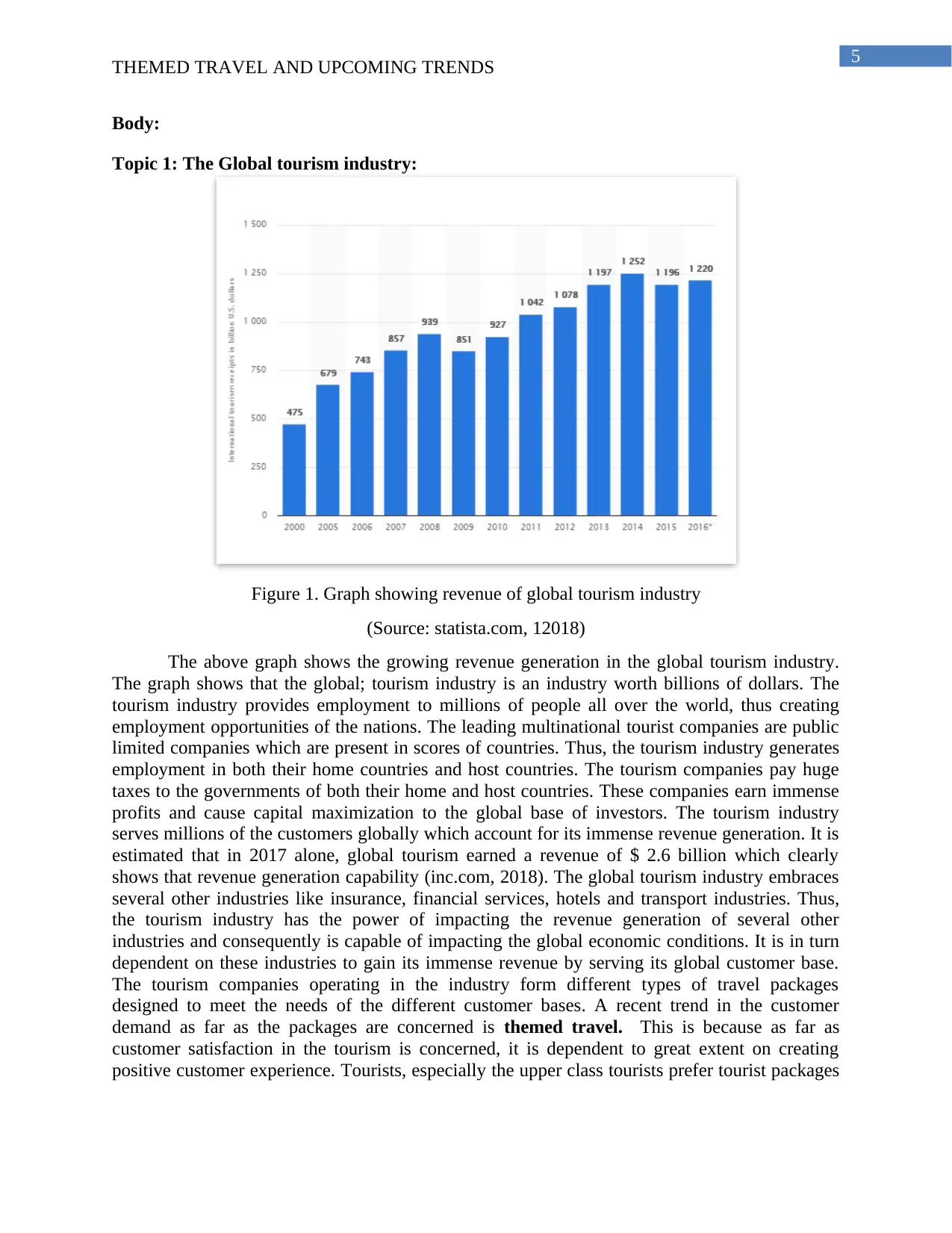
5
THEMED TRAVEL AND UPCOMING TRENDS
Body:
Topic 1: The Global tourism industry:
Figure 1. Graph showing revenue of global tourism industry
(Source: statista.com, 12018)
The above graph shows the growing revenue generation in the global tourism industry.
The graph shows that the global; tourism industry is an industry worth billions of dollars. The
tourism industry provides employment to millions of people all over the world, thus creating
employment opportunities of the nations. The leading multinational tourist companies are public
limited companies which are present in scores of countries. Thus, the tourism industry generates
employment in both their home countries and host countries. The tourism companies pay huge
taxes to the governments of both their home and host countries. These companies earn immense
profits and cause capital maximization to the global base of investors. The tourism industry
serves millions of the customers globally which account for its immense revenue generation. It is
estimated that in 2017 alone, global tourism earned a revenue of $ 2.6 billion which clearly
shows that revenue generation capability (inc.com, 2018). The global tourism industry embraces
several other industries like insurance, financial services, hotels and transport industries. Thus,
the tourism industry has the power of impacting the revenue generation of several other
industries and consequently is capable of impacting the global economic conditions. It is in turn
dependent on these industries to gain its immense revenue by serving its global customer base.
The tourism companies operating in the industry form different types of travel packages
designed to meet the needs of the different customer bases. A recent trend in the customer
demand as far as the packages are concerned is themed travel. This is because as far as
customer satisfaction in the tourism is concerned, it is dependent to great extent on creating
positive customer experience. Tourists, especially the upper class tourists prefer tourist packages
THEMED TRAVEL AND UPCOMING TRENDS
Body:
Topic 1: The Global tourism industry:
Figure 1. Graph showing revenue of global tourism industry
(Source: statista.com, 12018)
The above graph shows the growing revenue generation in the global tourism industry.
The graph shows that the global; tourism industry is an industry worth billions of dollars. The
tourism industry provides employment to millions of people all over the world, thus creating
employment opportunities of the nations. The leading multinational tourist companies are public
limited companies which are present in scores of countries. Thus, the tourism industry generates
employment in both their home countries and host countries. The tourism companies pay huge
taxes to the governments of both their home and host countries. These companies earn immense
profits and cause capital maximization to the global base of investors. The tourism industry
serves millions of the customers globally which account for its immense revenue generation. It is
estimated that in 2017 alone, global tourism earned a revenue of $ 2.6 billion which clearly
shows that revenue generation capability (inc.com, 2018). The global tourism industry embraces
several other industries like insurance, financial services, hotels and transport industries. Thus,
the tourism industry has the power of impacting the revenue generation of several other
industries and consequently is capable of impacting the global economic conditions. It is in turn
dependent on these industries to gain its immense revenue by serving its global customer base.
The tourism companies operating in the industry form different types of travel packages
designed to meet the needs of the different customer bases. A recent trend in the customer
demand as far as the packages are concerned is themed travel. This is because as far as
customer satisfaction in the tourism is concerned, it is dependent to great extent on creating
positive customer experience. Tourists, especially the upper class tourists prefer tourist packages
⊘ This is a preview!⊘
Do you want full access?
Subscribe today to unlock all pages.

Trusted by 1+ million students worldwide
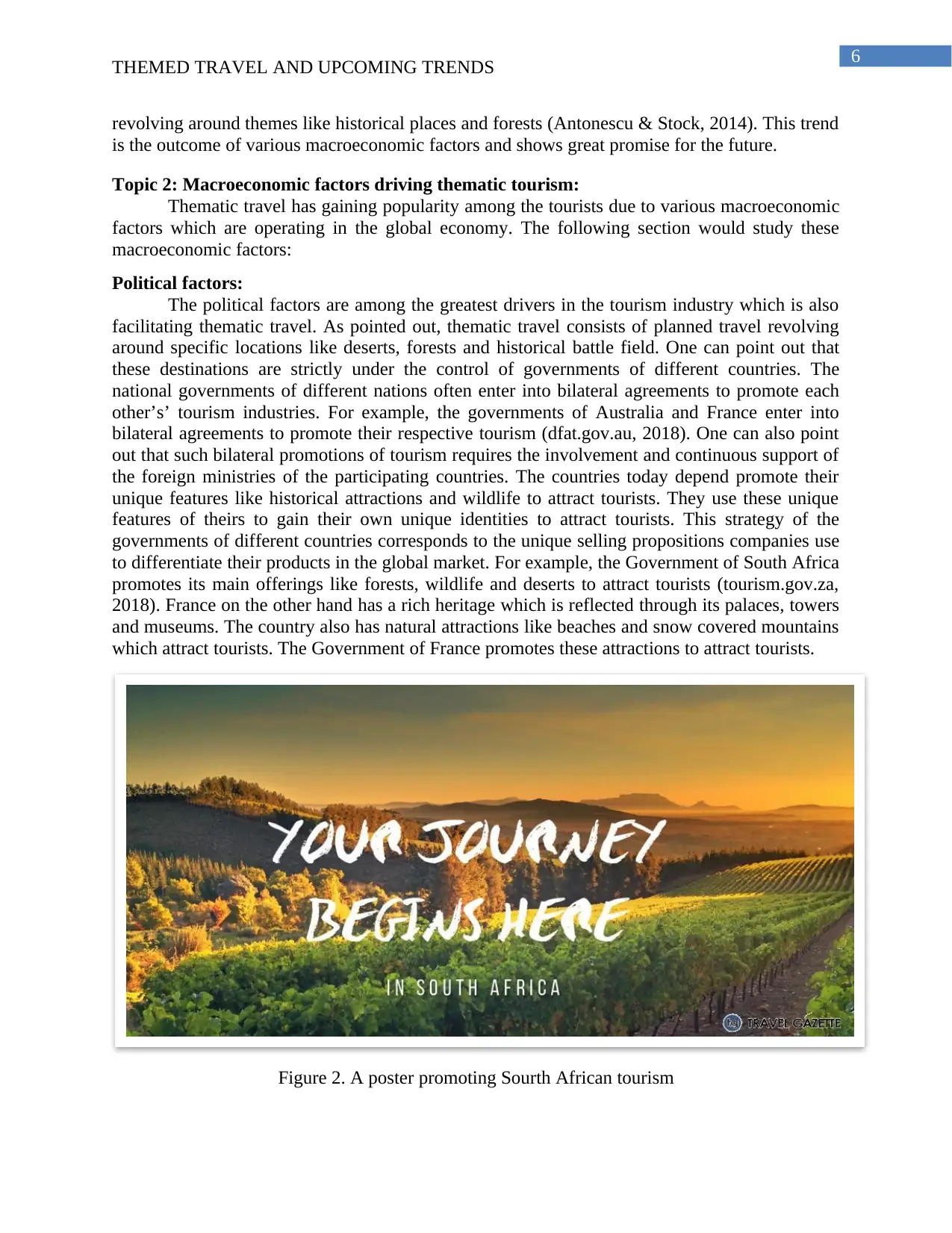
6
THEMED TRAVEL AND UPCOMING TRENDS
revolving around themes like historical places and forests (Antonescu & Stock, 2014). This trend
is the outcome of various macroeconomic factors and shows great promise for the future.
Topic 2: Macroeconomic factors driving thematic tourism:
Thematic travel has gaining popularity among the tourists due to various macroeconomic
factors which are operating in the global economy. The following section would study these
macroeconomic factors:
Political factors:
The political factors are among the greatest drivers in the tourism industry which is also
facilitating thematic travel. As pointed out, thematic travel consists of planned travel revolving
around specific locations like deserts, forests and historical battle field. One can point out that
these destinations are strictly under the control of governments of different countries. The
national governments of different nations often enter into bilateral agreements to promote each
other’s’ tourism industries. For example, the governments of Australia and France enter into
bilateral agreements to promote their respective tourism (dfat.gov.au, 2018). One can also point
out that such bilateral promotions of tourism requires the involvement and continuous support of
the foreign ministries of the participating countries. The countries today depend promote their
unique features like historical attractions and wildlife to attract tourists. They use these unique
features of theirs to gain their own unique identities to attract tourists. This strategy of the
governments of different countries corresponds to the unique selling propositions companies use
to differentiate their products in the global market. For example, the Government of South Africa
promotes its main offerings like forests, wildlife and deserts to attract tourists (tourism.gov.za,
2018). France on the other hand has a rich heritage which is reflected through its palaces, towers
and museums. The country also has natural attractions like beaches and snow covered mountains
which attract tourists. The Government of France promotes these attractions to attract tourists.
Figure 2. A poster promoting Sourth African tourism
THEMED TRAVEL AND UPCOMING TRENDS
revolving around themes like historical places and forests (Antonescu & Stock, 2014). This trend
is the outcome of various macroeconomic factors and shows great promise for the future.
Topic 2: Macroeconomic factors driving thematic tourism:
Thematic travel has gaining popularity among the tourists due to various macroeconomic
factors which are operating in the global economy. The following section would study these
macroeconomic factors:
Political factors:
The political factors are among the greatest drivers in the tourism industry which is also
facilitating thematic travel. As pointed out, thematic travel consists of planned travel revolving
around specific locations like deserts, forests and historical battle field. One can point out that
these destinations are strictly under the control of governments of different countries. The
national governments of different nations often enter into bilateral agreements to promote each
other’s’ tourism industries. For example, the governments of Australia and France enter into
bilateral agreements to promote their respective tourism (dfat.gov.au, 2018). One can also point
out that such bilateral promotions of tourism requires the involvement and continuous support of
the foreign ministries of the participating countries. The countries today depend promote their
unique features like historical attractions and wildlife to attract tourists. They use these unique
features of theirs to gain their own unique identities to attract tourists. This strategy of the
governments of different countries corresponds to the unique selling propositions companies use
to differentiate their products in the global market. For example, the Government of South Africa
promotes its main offerings like forests, wildlife and deserts to attract tourists (tourism.gov.za,
2018). France on the other hand has a rich heritage which is reflected through its palaces, towers
and museums. The country also has natural attractions like beaches and snow covered mountains
which attract tourists. The Government of France promotes these attractions to attract tourists.
Figure 2. A poster promoting Sourth African tourism
Paraphrase This Document
Need a fresh take? Get an instant paraphrase of this document with our AI Paraphraser
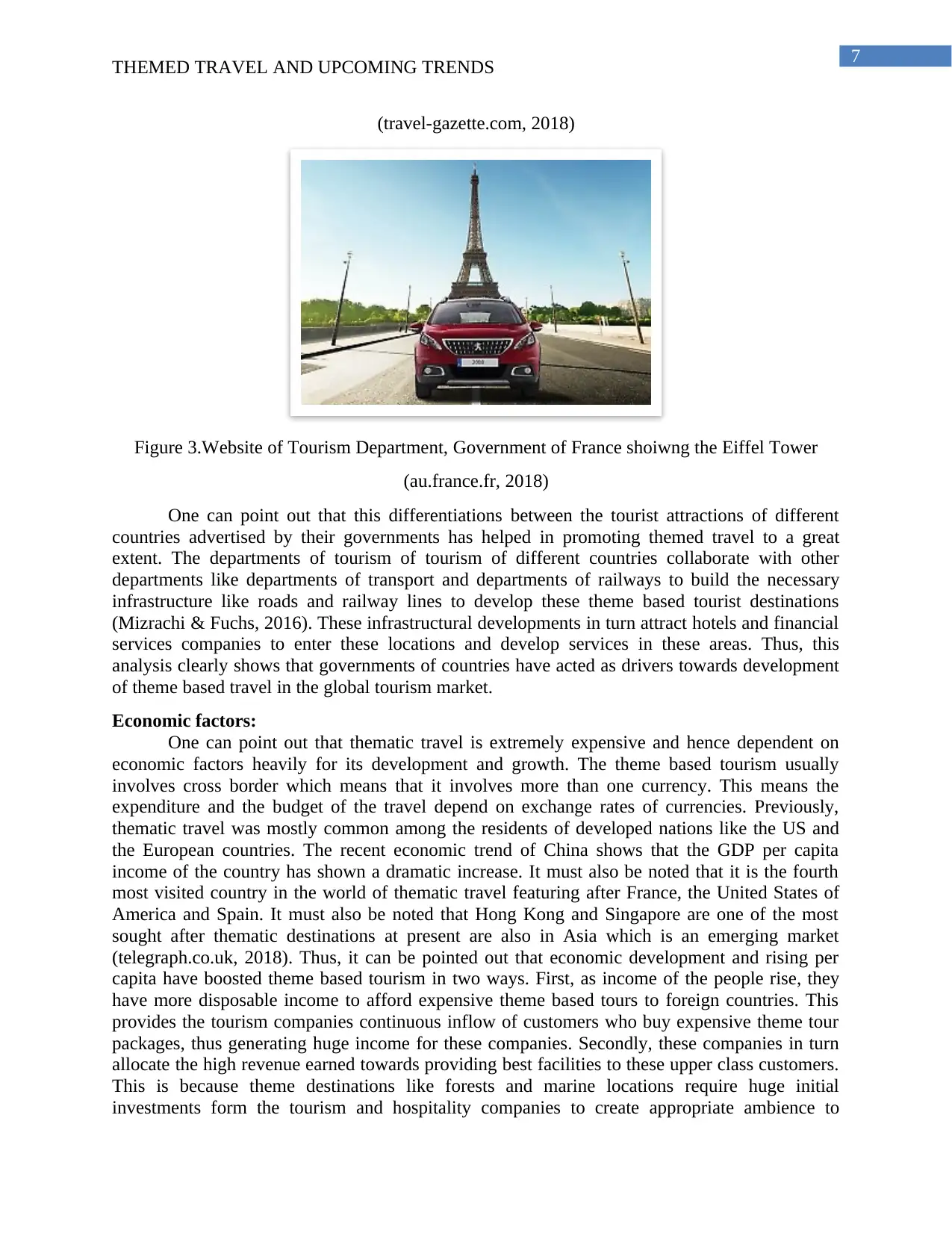
7
THEMED TRAVEL AND UPCOMING TRENDS
(travel-gazette.com, 2018)
Figure 3.Website of Tourism Department, Government of France shoiwng the Eiffel Tower
(au.france.fr, 2018)
One can point out that this differentiations between the tourist attractions of different
countries advertised by their governments has helped in promoting themed travel to a great
extent. The departments of tourism of tourism of different countries collaborate with other
departments like departments of transport and departments of railways to build the necessary
infrastructure like roads and railway lines to develop these theme based tourist destinations
(Mizrachi & Fuchs, 2016). These infrastructural developments in turn attract hotels and financial
services companies to enter these locations and develop services in these areas. Thus, this
analysis clearly shows that governments of countries have acted as drivers towards development
of theme based travel in the global tourism market.
Economic factors:
One can point out that thematic travel is extremely expensive and hence dependent on
economic factors heavily for its development and growth. The theme based tourism usually
involves cross border which means that it involves more than one currency. This means the
expenditure and the budget of the travel depend on exchange rates of currencies. Previously,
thematic travel was mostly common among the residents of developed nations like the US and
the European countries. The recent economic trend of China shows that the GDP per capita
income of the country has shown a dramatic increase. It must also be noted that it is the fourth
most visited country in the world of thematic travel featuring after France, the United States of
America and Spain. It must also be noted that Hong Kong and Singapore are one of the most
sought after thematic destinations at present are also in Asia which is an emerging market
(telegraph.co.uk, 2018). Thus, it can be pointed out that economic development and rising per
capita have boosted theme based tourism in two ways. First, as income of the people rise, they
have more disposable income to afford expensive theme based tours to foreign countries. This
provides the tourism companies continuous inflow of customers who buy expensive theme tour
packages, thus generating huge income for these companies. Secondly, these companies in turn
allocate the high revenue earned towards providing best facilities to these upper class customers.
This is because theme destinations like forests and marine locations require huge initial
investments form the tourism and hospitality companies to create appropriate ambience to
THEMED TRAVEL AND UPCOMING TRENDS
(travel-gazette.com, 2018)
Figure 3.Website of Tourism Department, Government of France shoiwng the Eiffel Tower
(au.france.fr, 2018)
One can point out that this differentiations between the tourist attractions of different
countries advertised by their governments has helped in promoting themed travel to a great
extent. The departments of tourism of tourism of different countries collaborate with other
departments like departments of transport and departments of railways to build the necessary
infrastructure like roads and railway lines to develop these theme based tourist destinations
(Mizrachi & Fuchs, 2016). These infrastructural developments in turn attract hotels and financial
services companies to enter these locations and develop services in these areas. Thus, this
analysis clearly shows that governments of countries have acted as drivers towards development
of theme based travel in the global tourism market.
Economic factors:
One can point out that thematic travel is extremely expensive and hence dependent on
economic factors heavily for its development and growth. The theme based tourism usually
involves cross border which means that it involves more than one currency. This means the
expenditure and the budget of the travel depend on exchange rates of currencies. Previously,
thematic travel was mostly common among the residents of developed nations like the US and
the European countries. The recent economic trend of China shows that the GDP per capita
income of the country has shown a dramatic increase. It must also be noted that it is the fourth
most visited country in the world of thematic travel featuring after France, the United States of
America and Spain. It must also be noted that Hong Kong and Singapore are one of the most
sought after thematic destinations at present are also in Asia which is an emerging market
(telegraph.co.uk, 2018). Thus, it can be pointed out that economic development and rising per
capita have boosted theme based tourism in two ways. First, as income of the people rise, they
have more disposable income to afford expensive theme based tours to foreign countries. This
provides the tourism companies continuous inflow of customers who buy expensive theme tour
packages, thus generating huge income for these companies. Secondly, these companies in turn
allocate the high revenue earned towards providing best facilities to these upper class customers.
This is because theme destinations like forests and marine locations require huge initial
investments form the tourism and hospitality companies to create appropriate ambience to
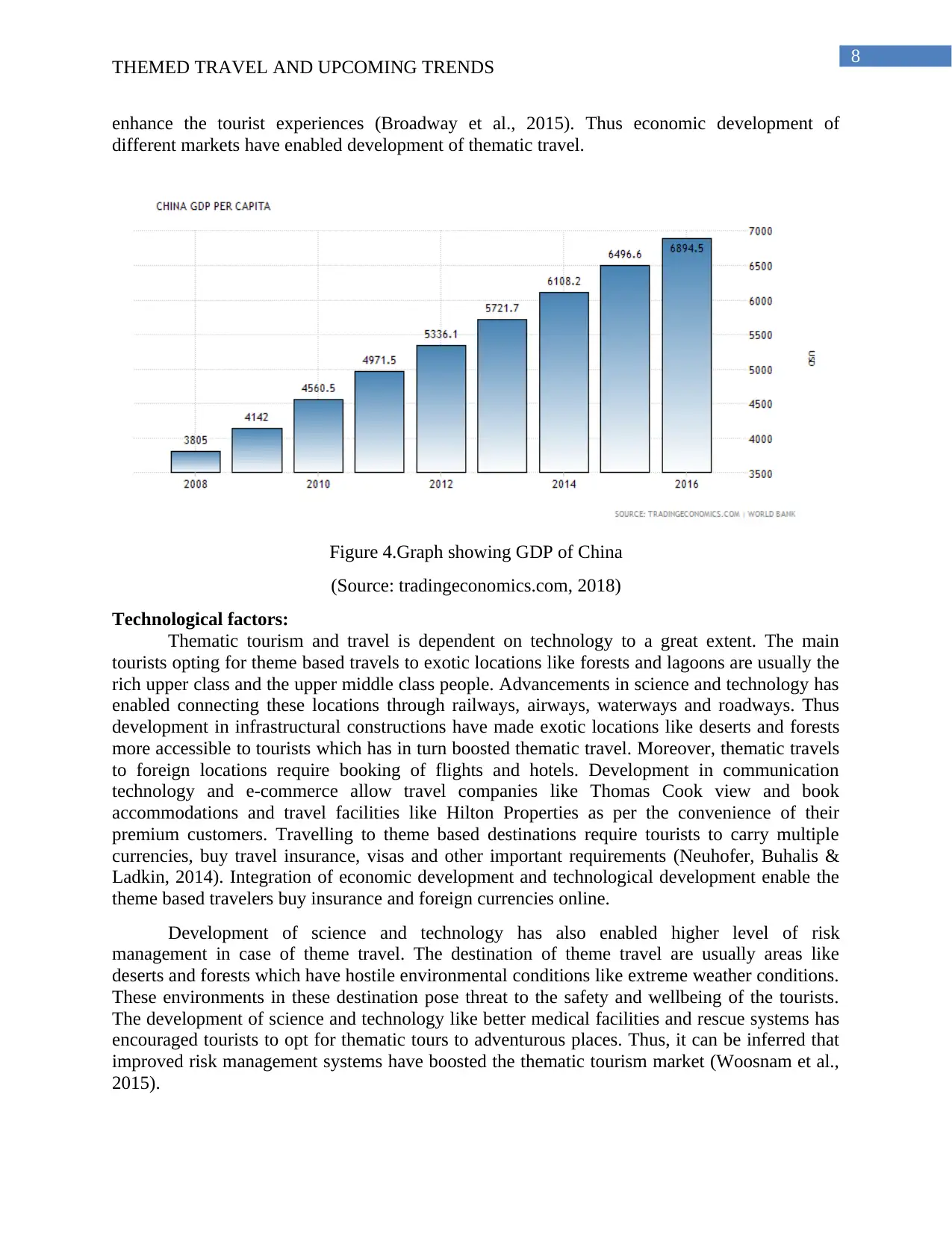
8
THEMED TRAVEL AND UPCOMING TRENDS
enhance the tourist experiences (Broadway et al., 2015). Thus economic development of
different markets have enabled development of thematic travel.
Figure 4.Graph showing GDP of China
(Source: tradingeconomics.com, 2018)
Technological factors:
Thematic tourism and travel is dependent on technology to a great extent. The main
tourists opting for theme based travels to exotic locations like forests and lagoons are usually the
rich upper class and the upper middle class people. Advancements in science and technology has
enabled connecting these locations through railways, airways, waterways and roadways. Thus
development in infrastructural constructions have made exotic locations like deserts and forests
more accessible to tourists which has in turn boosted thematic travel. Moreover, thematic travels
to foreign locations require booking of flights and hotels. Development in communication
technology and e-commerce allow travel companies like Thomas Cook view and book
accommodations and travel facilities like Hilton Properties as per the convenience of their
premium customers. Travelling to theme based destinations require tourists to carry multiple
currencies, buy travel insurance, visas and other important requirements (Neuhofer, Buhalis &
Ladkin, 2014). Integration of economic development and technological development enable the
theme based travelers buy insurance and foreign currencies online.
Development of science and technology has also enabled higher level of risk
management in case of theme travel. The destination of theme travel are usually areas like
deserts and forests which have hostile environmental conditions like extreme weather conditions.
These environments in these destination pose threat to the safety and wellbeing of the tourists.
The development of science and technology like better medical facilities and rescue systems has
encouraged tourists to opt for thematic tours to adventurous places. Thus, it can be inferred that
improved risk management systems have boosted the thematic tourism market (Woosnam et al.,
2015).
THEMED TRAVEL AND UPCOMING TRENDS
enhance the tourist experiences (Broadway et al., 2015). Thus economic development of
different markets have enabled development of thematic travel.
Figure 4.Graph showing GDP of China
(Source: tradingeconomics.com, 2018)
Technological factors:
Thematic tourism and travel is dependent on technology to a great extent. The main
tourists opting for theme based travels to exotic locations like forests and lagoons are usually the
rich upper class and the upper middle class people. Advancements in science and technology has
enabled connecting these locations through railways, airways, waterways and roadways. Thus
development in infrastructural constructions have made exotic locations like deserts and forests
more accessible to tourists which has in turn boosted thematic travel. Moreover, thematic travels
to foreign locations require booking of flights and hotels. Development in communication
technology and e-commerce allow travel companies like Thomas Cook view and book
accommodations and travel facilities like Hilton Properties as per the convenience of their
premium customers. Travelling to theme based destinations require tourists to carry multiple
currencies, buy travel insurance, visas and other important requirements (Neuhofer, Buhalis &
Ladkin, 2014). Integration of economic development and technological development enable the
theme based travelers buy insurance and foreign currencies online.
Development of science and technology has also enabled higher level of risk
management in case of theme travel. The destination of theme travel are usually areas like
deserts and forests which have hostile environmental conditions like extreme weather conditions.
These environments in these destination pose threat to the safety and wellbeing of the tourists.
The development of science and technology like better medical facilities and rescue systems has
encouraged tourists to opt for thematic tours to adventurous places. Thus, it can be inferred that
improved risk management systems have boosted the thematic tourism market (Woosnam et al.,
2015).
⊘ This is a preview!⊘
Do you want full access?
Subscribe today to unlock all pages.

Trusted by 1+ million students worldwide
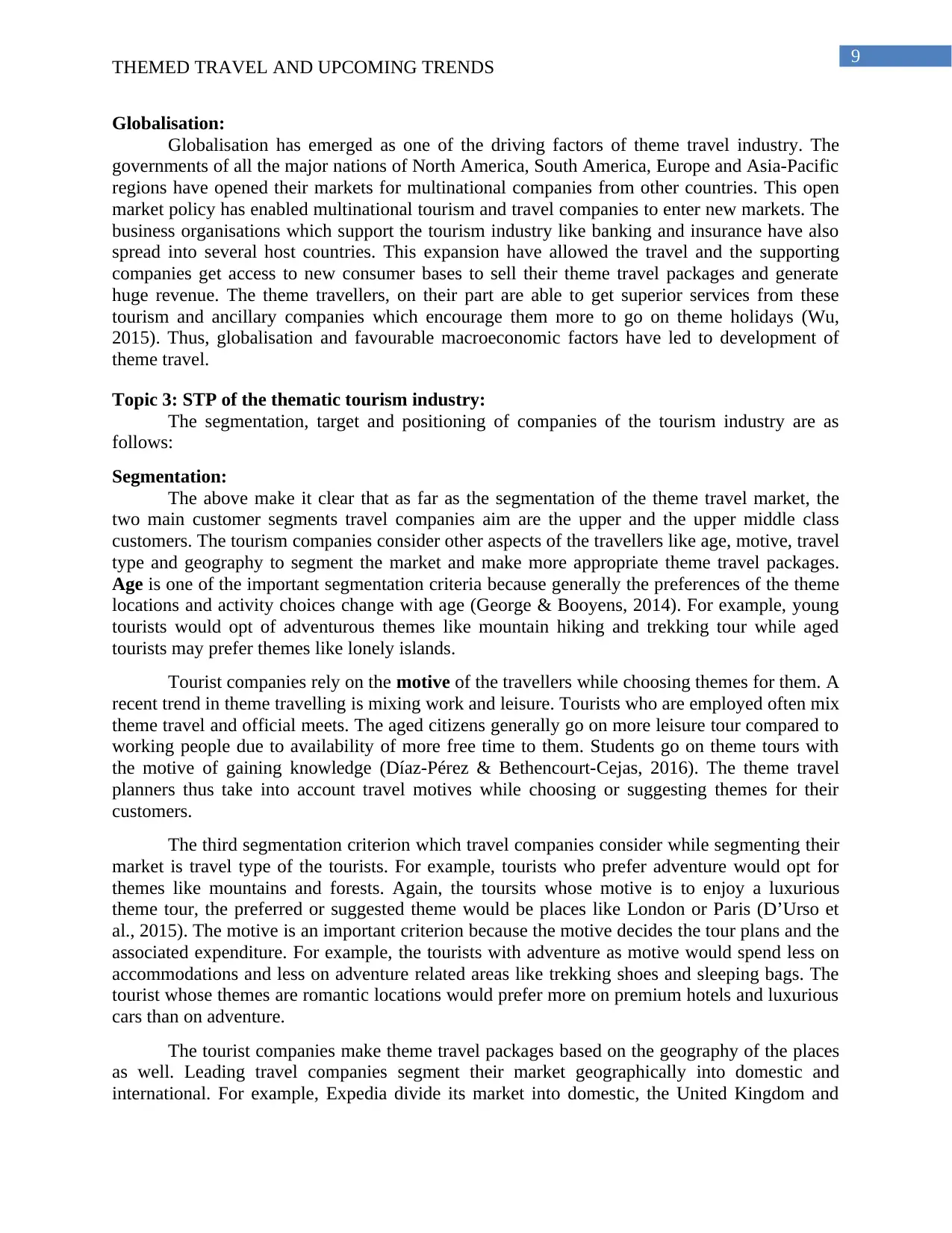
9
THEMED TRAVEL AND UPCOMING TRENDS
Globalisation:
Globalisation has emerged as one of the driving factors of theme travel industry. The
governments of all the major nations of North America, South America, Europe and Asia-Pacific
regions have opened their markets for multinational companies from other countries. This open
market policy has enabled multinational tourism and travel companies to enter new markets. The
business organisations which support the tourism industry like banking and insurance have also
spread into several host countries. This expansion have allowed the travel and the supporting
companies get access to new consumer bases to sell their theme travel packages and generate
huge revenue. The theme travellers, on their part are able to get superior services from these
tourism and ancillary companies which encourage them more to go on theme holidays (Wu,
2015). Thus, globalisation and favourable macroeconomic factors have led to development of
theme travel.
Topic 3: STP of the thematic tourism industry:
The segmentation, target and positioning of companies of the tourism industry are as
follows:
Segmentation:
The above make it clear that as far as the segmentation of the theme travel market, the
two main customer segments travel companies aim are the upper and the upper middle class
customers. The tourism companies consider other aspects of the travellers like age, motive, travel
type and geography to segment the market and make more appropriate theme travel packages.
Age is one of the important segmentation criteria because generally the preferences of the theme
locations and activity choices change with age (George & Booyens, 2014). For example, young
tourists would opt of adventurous themes like mountain hiking and trekking tour while aged
tourists may prefer themes like lonely islands.
Tourist companies rely on the motive of the travellers while choosing themes for them. A
recent trend in theme travelling is mixing work and leisure. Tourists who are employed often mix
theme travel and official meets. The aged citizens generally go on more leisure tour compared to
working people due to availability of more free time to them. Students go on theme tours with
the motive of gaining knowledge (Díaz-Pérez & Bethencourt-Cejas, 2016). The theme travel
planners thus take into account travel motives while choosing or suggesting themes for their
customers.
The third segmentation criterion which travel companies consider while segmenting their
market is travel type of the tourists. For example, tourists who prefer adventure would opt for
themes like mountains and forests. Again, the toursits whose motive is to enjoy a luxurious
theme tour, the preferred or suggested theme would be places like London or Paris (D’Urso et
al., 2015). The motive is an important criterion because the motive decides the tour plans and the
associated expenditure. For example, the tourists with adventure as motive would spend less on
accommodations and less on adventure related areas like trekking shoes and sleeping bags. The
tourist whose themes are romantic locations would prefer more on premium hotels and luxurious
cars than on adventure.
The tourist companies make theme travel packages based on the geography of the places
as well. Leading travel companies segment their market geographically into domestic and
international. For example, Expedia divide its market into domestic, the United Kingdom and
THEMED TRAVEL AND UPCOMING TRENDS
Globalisation:
Globalisation has emerged as one of the driving factors of theme travel industry. The
governments of all the major nations of North America, South America, Europe and Asia-Pacific
regions have opened their markets for multinational companies from other countries. This open
market policy has enabled multinational tourism and travel companies to enter new markets. The
business organisations which support the tourism industry like banking and insurance have also
spread into several host countries. This expansion have allowed the travel and the supporting
companies get access to new consumer bases to sell their theme travel packages and generate
huge revenue. The theme travellers, on their part are able to get superior services from these
tourism and ancillary companies which encourage them more to go on theme holidays (Wu,
2015). Thus, globalisation and favourable macroeconomic factors have led to development of
theme travel.
Topic 3: STP of the thematic tourism industry:
The segmentation, target and positioning of companies of the tourism industry are as
follows:
Segmentation:
The above make it clear that as far as the segmentation of the theme travel market, the
two main customer segments travel companies aim are the upper and the upper middle class
customers. The tourism companies consider other aspects of the travellers like age, motive, travel
type and geography to segment the market and make more appropriate theme travel packages.
Age is one of the important segmentation criteria because generally the preferences of the theme
locations and activity choices change with age (George & Booyens, 2014). For example, young
tourists would opt of adventurous themes like mountain hiking and trekking tour while aged
tourists may prefer themes like lonely islands.
Tourist companies rely on the motive of the travellers while choosing themes for them. A
recent trend in theme travelling is mixing work and leisure. Tourists who are employed often mix
theme travel and official meets. The aged citizens generally go on more leisure tour compared to
working people due to availability of more free time to them. Students go on theme tours with
the motive of gaining knowledge (Díaz-Pérez & Bethencourt-Cejas, 2016). The theme travel
planners thus take into account travel motives while choosing or suggesting themes for their
customers.
The third segmentation criterion which travel companies consider while segmenting their
market is travel type of the tourists. For example, tourists who prefer adventure would opt for
themes like mountains and forests. Again, the toursits whose motive is to enjoy a luxurious
theme tour, the preferred or suggested theme would be places like London or Paris (D’Urso et
al., 2015). The motive is an important criterion because the motive decides the tour plans and the
associated expenditure. For example, the tourists with adventure as motive would spend less on
accommodations and less on adventure related areas like trekking shoes and sleeping bags. The
tourist whose themes are romantic locations would prefer more on premium hotels and luxurious
cars than on adventure.
The tourist companies make theme travel packages based on the geography of the places
as well. Leading travel companies segment their market geographically into domestic and
international. For example, Expedia divide its market into domestic, the United Kingdom and
Paraphrase This Document
Need a fresh take? Get an instant paraphrase of this document with our AI Paraphraser
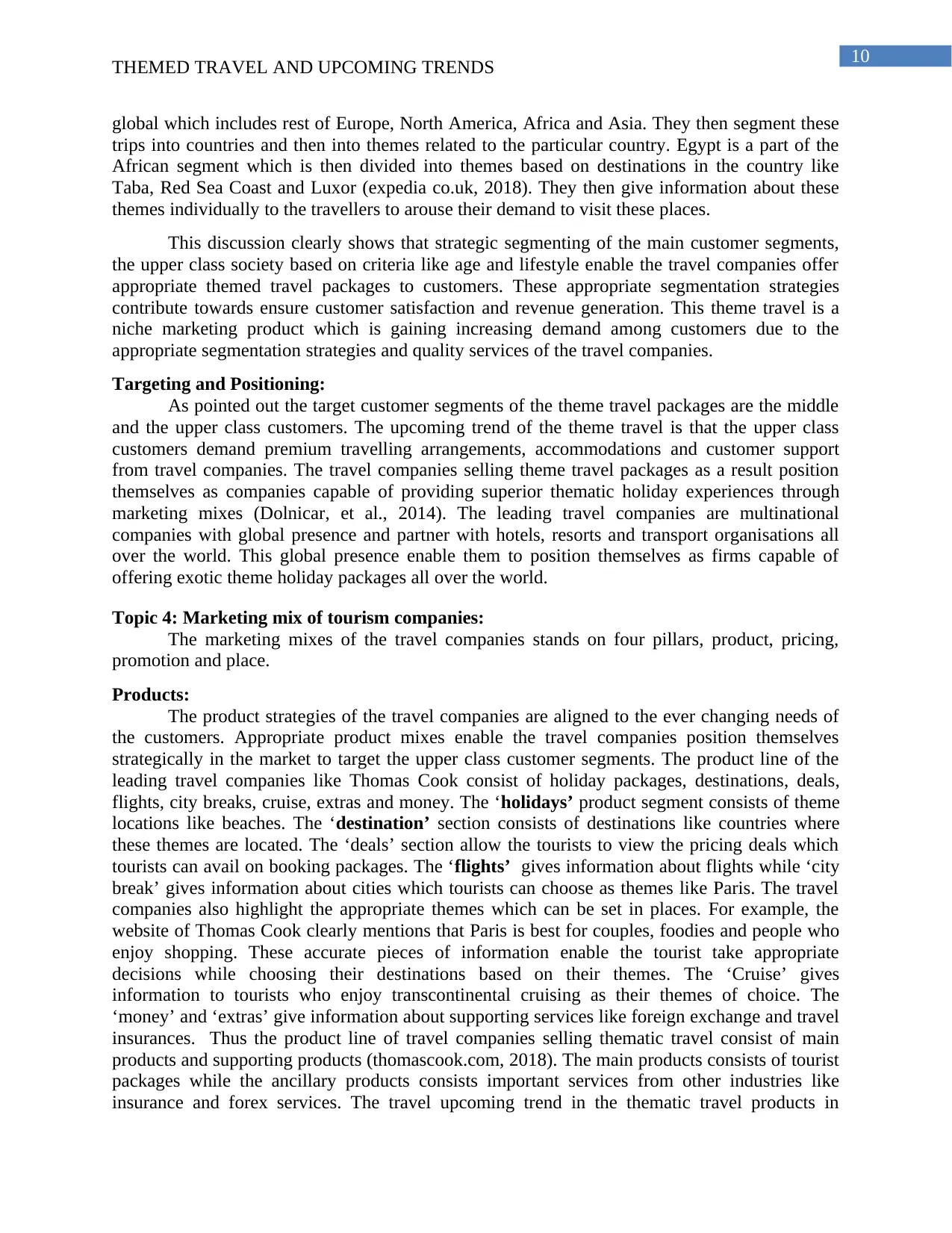
10
THEMED TRAVEL AND UPCOMING TRENDS
global which includes rest of Europe, North America, Africa and Asia. They then segment these
trips into countries and then into themes related to the particular country. Egypt is a part of the
African segment which is then divided into themes based on destinations in the country like
Taba, Red Sea Coast and Luxor (expedia co.uk, 2018). They then give information about these
themes individually to the travellers to arouse their demand to visit these places.
This discussion clearly shows that strategic segmenting of the main customer segments,
the upper class society based on criteria like age and lifestyle enable the travel companies offer
appropriate themed travel packages to customers. These appropriate segmentation strategies
contribute towards ensure customer satisfaction and revenue generation. This theme travel is a
niche marketing product which is gaining increasing demand among customers due to the
appropriate segmentation strategies and quality services of the travel companies.
Targeting and Positioning:
As pointed out the target customer segments of the theme travel packages are the middle
and the upper class customers. The upcoming trend of the theme travel is that the upper class
customers demand premium travelling arrangements, accommodations and customer support
from travel companies. The travel companies selling theme travel packages as a result position
themselves as companies capable of providing superior thematic holiday experiences through
marketing mixes (Dolnicar, et al., 2014). The leading travel companies are multinational
companies with global presence and partner with hotels, resorts and transport organisations all
over the world. This global presence enable them to position themselves as firms capable of
offering exotic theme holiday packages all over the world.
Topic 4: Marketing mix of tourism companies:
The marketing mixes of the travel companies stands on four pillars, product, pricing,
promotion and place.
Products:
The product strategies of the travel companies are aligned to the ever changing needs of
the customers. Appropriate product mixes enable the travel companies position themselves
strategically in the market to target the upper class customer segments. The product line of the
leading travel companies like Thomas Cook consist of holiday packages, destinations, deals,
flights, city breaks, cruise, extras and money. The ‘holidays’ product segment consists of theme
locations like beaches. The ‘destination’ section consists of destinations like countries where
these themes are located. The ‘deals’ section allow the tourists to view the pricing deals which
tourists can avail on booking packages. The ‘flights’ gives information about flights while ‘city
break’ gives information about cities which tourists can choose as themes like Paris. The travel
companies also highlight the appropriate themes which can be set in places. For example, the
website of Thomas Cook clearly mentions that Paris is best for couples, foodies and people who
enjoy shopping. These accurate pieces of information enable the tourist take appropriate
decisions while choosing their destinations based on their themes. The ‘Cruise’ gives
information to tourists who enjoy transcontinental cruising as their themes of choice. The
‘money’ and ‘extras’ give information about supporting services like foreign exchange and travel
insurances. Thus the product line of travel companies selling thematic travel consist of main
products and supporting products (thomascook.com, 2018). The main products consists of tourist
packages while the ancillary products consists important services from other industries like
insurance and forex services. The travel upcoming trend in the thematic travel products in
THEMED TRAVEL AND UPCOMING TRENDS
global which includes rest of Europe, North America, Africa and Asia. They then segment these
trips into countries and then into themes related to the particular country. Egypt is a part of the
African segment which is then divided into themes based on destinations in the country like
Taba, Red Sea Coast and Luxor (expedia co.uk, 2018). They then give information about these
themes individually to the travellers to arouse their demand to visit these places.
This discussion clearly shows that strategic segmenting of the main customer segments,
the upper class society based on criteria like age and lifestyle enable the travel companies offer
appropriate themed travel packages to customers. These appropriate segmentation strategies
contribute towards ensure customer satisfaction and revenue generation. This theme travel is a
niche marketing product which is gaining increasing demand among customers due to the
appropriate segmentation strategies and quality services of the travel companies.
Targeting and Positioning:
As pointed out the target customer segments of the theme travel packages are the middle
and the upper class customers. The upcoming trend of the theme travel is that the upper class
customers demand premium travelling arrangements, accommodations and customer support
from travel companies. The travel companies selling theme travel packages as a result position
themselves as companies capable of providing superior thematic holiday experiences through
marketing mixes (Dolnicar, et al., 2014). The leading travel companies are multinational
companies with global presence and partner with hotels, resorts and transport organisations all
over the world. This global presence enable them to position themselves as firms capable of
offering exotic theme holiday packages all over the world.
Topic 4: Marketing mix of tourism companies:
The marketing mixes of the travel companies stands on four pillars, product, pricing,
promotion and place.
Products:
The product strategies of the travel companies are aligned to the ever changing needs of
the customers. Appropriate product mixes enable the travel companies position themselves
strategically in the market to target the upper class customer segments. The product line of the
leading travel companies like Thomas Cook consist of holiday packages, destinations, deals,
flights, city breaks, cruise, extras and money. The ‘holidays’ product segment consists of theme
locations like beaches. The ‘destination’ section consists of destinations like countries where
these themes are located. The ‘deals’ section allow the tourists to view the pricing deals which
tourists can avail on booking packages. The ‘flights’ gives information about flights while ‘city
break’ gives information about cities which tourists can choose as themes like Paris. The travel
companies also highlight the appropriate themes which can be set in places. For example, the
website of Thomas Cook clearly mentions that Paris is best for couples, foodies and people who
enjoy shopping. These accurate pieces of information enable the tourist take appropriate
decisions while choosing their destinations based on their themes. The ‘Cruise’ gives
information to tourists who enjoy transcontinental cruising as their themes of choice. The
‘money’ and ‘extras’ give information about supporting services like foreign exchange and travel
insurances. Thus the product line of travel companies selling thematic travel consist of main
products and supporting products (thomascook.com, 2018). The main products consists of tourist
packages while the ancillary products consists important services from other industries like
insurance and forex services. The travel upcoming trend in the thematic travel products in
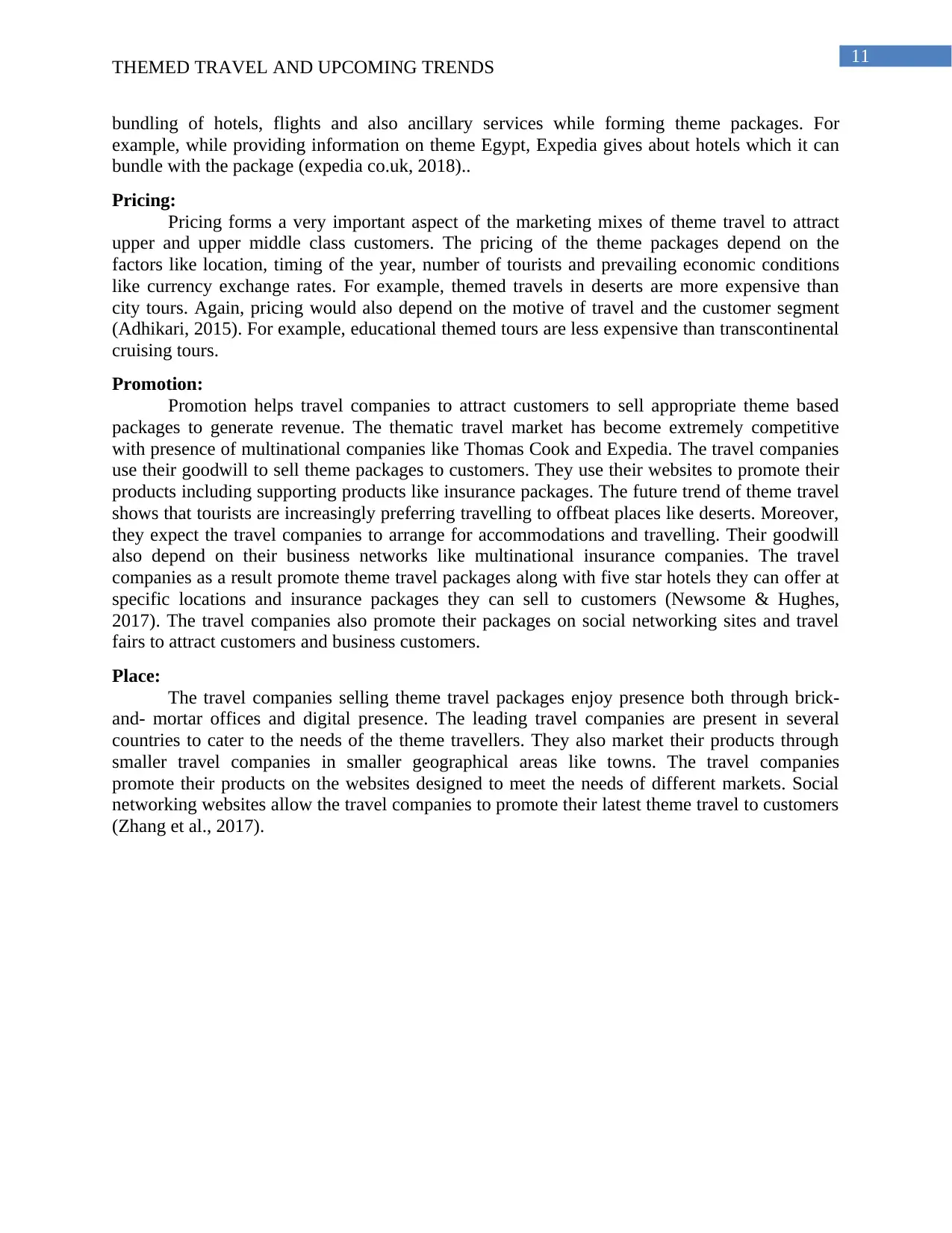
11
THEMED TRAVEL AND UPCOMING TRENDS
bundling of hotels, flights and also ancillary services while forming theme packages. For
example, while providing information on theme Egypt, Expedia gives about hotels which it can
bundle with the package (expedia co.uk, 2018)..
Pricing:
Pricing forms a very important aspect of the marketing mixes of theme travel to attract
upper and upper middle class customers. The pricing of the theme packages depend on the
factors like location, timing of the year, number of tourists and prevailing economic conditions
like currency exchange rates. For example, themed travels in deserts are more expensive than
city tours. Again, pricing would also depend on the motive of travel and the customer segment
(Adhikari, 2015). For example, educational themed tours are less expensive than transcontinental
cruising tours.
Promotion:
Promotion helps travel companies to attract customers to sell appropriate theme based
packages to generate revenue. The thematic travel market has become extremely competitive
with presence of multinational companies like Thomas Cook and Expedia. The travel companies
use their goodwill to sell theme packages to customers. They use their websites to promote their
products including supporting products like insurance packages. The future trend of theme travel
shows that tourists are increasingly preferring travelling to offbeat places like deserts. Moreover,
they expect the travel companies to arrange for accommodations and travelling. Their goodwill
also depend on their business networks like multinational insurance companies. The travel
companies as a result promote theme travel packages along with five star hotels they can offer at
specific locations and insurance packages they can sell to customers (Newsome & Hughes,
2017). The travel companies also promote their packages on social networking sites and travel
fairs to attract customers and business customers.
Place:
The travel companies selling theme travel packages enjoy presence both through brick-
and- mortar offices and digital presence. The leading travel companies are present in several
countries to cater to the needs of the theme travellers. They also market their products through
smaller travel companies in smaller geographical areas like towns. The travel companies
promote their products on the websites designed to meet the needs of different markets. Social
networking websites allow the travel companies to promote their latest theme travel to customers
(Zhang et al., 2017).
THEMED TRAVEL AND UPCOMING TRENDS
bundling of hotels, flights and also ancillary services while forming theme packages. For
example, while providing information on theme Egypt, Expedia gives about hotels which it can
bundle with the package (expedia co.uk, 2018)..
Pricing:
Pricing forms a very important aspect of the marketing mixes of theme travel to attract
upper and upper middle class customers. The pricing of the theme packages depend on the
factors like location, timing of the year, number of tourists and prevailing economic conditions
like currency exchange rates. For example, themed travels in deserts are more expensive than
city tours. Again, pricing would also depend on the motive of travel and the customer segment
(Adhikari, 2015). For example, educational themed tours are less expensive than transcontinental
cruising tours.
Promotion:
Promotion helps travel companies to attract customers to sell appropriate theme based
packages to generate revenue. The thematic travel market has become extremely competitive
with presence of multinational companies like Thomas Cook and Expedia. The travel companies
use their goodwill to sell theme packages to customers. They use their websites to promote their
products including supporting products like insurance packages. The future trend of theme travel
shows that tourists are increasingly preferring travelling to offbeat places like deserts. Moreover,
they expect the travel companies to arrange for accommodations and travelling. Their goodwill
also depend on their business networks like multinational insurance companies. The travel
companies as a result promote theme travel packages along with five star hotels they can offer at
specific locations and insurance packages they can sell to customers (Newsome & Hughes,
2017). The travel companies also promote their packages on social networking sites and travel
fairs to attract customers and business customers.
Place:
The travel companies selling theme travel packages enjoy presence both through brick-
and- mortar offices and digital presence. The leading travel companies are present in several
countries to cater to the needs of the theme travellers. They also market their products through
smaller travel companies in smaller geographical areas like towns. The travel companies
promote their products on the websites designed to meet the needs of different markets. Social
networking websites allow the travel companies to promote their latest theme travel to customers
(Zhang et al., 2017).
⊘ This is a preview!⊘
Do you want full access?
Subscribe today to unlock all pages.

Trusted by 1+ million students worldwide
1 out of 17
Related Documents
Your All-in-One AI-Powered Toolkit for Academic Success.
+13062052269
info@desklib.com
Available 24*7 on WhatsApp / Email
![[object Object]](/_next/static/media/star-bottom.7253800d.svg)
Unlock your academic potential
Copyright © 2020–2025 A2Z Services. All Rights Reserved. Developed and managed by ZUCOL.





